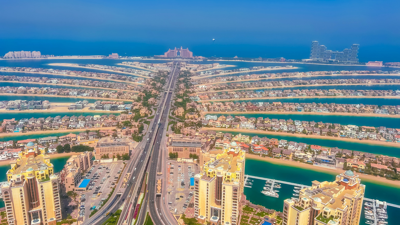Each month we spotlight recently published research from one of the Society’s leading international journals: Area, The Geographical Journal, Transactions of the Institute of British Geographers, and Geo: Geography and Environment. This month we’re featuring a paper from The Geographical Journal, exploring evaporation losses from swimming pools in Palm Jumeirah Island, Dubai, a region with a distinctively high density of residential pools. What consequences does this water loss have and what measures can be put in place to curb it?
Water loss in Palm Jumeirah
Palm Jumeirah is a 5km² artificial island in Dubai, playing host to around 2000 villas, multiple resorts, 40 five-star luxury hotels and 10,000 shoreline townhouses and apartments. Due to the hot and hyper-arid climate of the United Arab Emirates, estimated1,859 pools are also found on the island.
Recent research undertaken by geographers Alicia Cumberland and Rob Wilby, both from Loughborough University, used a GIS-based methodology to calculate the water losses from these swimming pools as a result of evaporation. The amount of water used in the UAE, around 550 litres per person per day according to figures from the Ministry of Climate Change and Environment, is one of the highest in the world. On top of this, 42% of potable water in the UAE has been processed by energy-intensive desalination plants which contribute significantly to the national carbon footprint.
Alicia and Rob’s research estimates that over 600 million litres of water evaporate from Palm Jumeirah’s swimming pools each year, equivalent to the annual water usage of around 3,000 people (one third of the island’s population). When scaled up across the UAE – with fairly conservative assumptions about the number of swimming pools, their surface area, and evaporation rates – this estimate points to potentially billions of litres of water lost through swimming pool evaporation every year. Additionally, this study found that around 1.2 million kg of CO₂ was used annually for the desalination of the replacement water for pool top-ups in Palm Jumeirah.
A win-win solution?
These losses could be reduced significantly by the use of pool covers, which could cut evaporation by as much as 95%. Given the heavy environmental cost of producing desalinated water, Alicia and Rob suggest that incentives could be adopted to encourage the use of covers, as is already the case in other countries:
In some other parts of the world, such as Victoria in Australia and Southern Nevada, financial incentives are used to encourage residents to install pool covers to reduce water loss. Similar measures could be considered in the UAE… for example, when people are not using a swimming pool, pool covers could be mandated… and subsidies could be provided to encourage this. This would be very beneficial, helping people save water and energy bills.Alicia
In addition to financial incentives, Alicia says: “new developments could install communal pools to be used by residents from a number of properties, instead of providing every home with its own pool.’
The swimming pool issue is about more than water, as put by Rob:
In the case of pools, we can reduce both carbon emissions and evaporated water by using covers … desalination is very energy intensive... so less energy would be needed to treat and pump the smaller amounts of water for topping up the pool. This win-win is especially important for hot and arid parts of the world like the UAE.Rob
Next steps
When scaled up to the whole UAE, implementing mandatory pool covers and favouring more community pools could play an important role in reducing residential water consumption. This will contribute to the achievement of targets in the UAE 2036 Water Security Strategy, which aims to reduce total demand for water resources by 21%. Lessons learnt from Dubai could also improve water conservation and energy savings across the wider region.
You can listen to Rob speak about this research on UAE radio here



